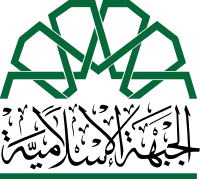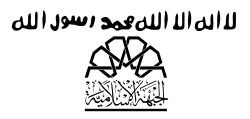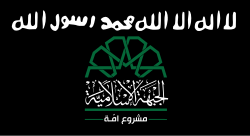Islamic Front (Syria)
| Islamic Front | |
|---|---|
| الجبهة الإسلامية | |
 Official logo of the Islamic Front  Administration flag  War flag | |
| Leaders | Ahmed Abu Issa[1] Zahran Alloush Hassan Abboud Abul-Abbas al-Shami Abu Rateb Abu Omar Hreitan |
| Dates of operation | 22 November 2013–present |
| Group(s) | |
| Headquarters | |
| Active regions | Syria |
| Ideology | Islamism[3] Salafism[4] |
| Part of | |
| Allies |
|
| Opponents | |
| Battles and wars | Syrian Civil War |
The Islamic Front (Template:Lang-ar, al-Jabhat al-Islāmiyyah) is a merger of seven rebel groups involved in the Syrian civil war[1] that was announced on 22 November 2013.[13] An anonymous spokesman for the group has stated that it will not have ties with the Syrian National Coalition,[14] though a member of the political bureau of the group, Ahmad Musa, has stated that he hopes for recognition from the Syrian National Council in cooperation for what he suggested "the Syrian people want. They want a revolution and not politics and foreign agendas."[15] The group is widely seen as backed and armed by Saudi Arabia.[16][17][18]
The Islamic Front's charter rejects the concepts of representative democracy and secularism, instead seeking to establish an Islamic state ruled by a Majlis-ash-Shura and implementing sharia.
History
Founding
On 22 November 2013, seven Islamist groups agreed to a pact that would dissolve the groups individually and lead to the formation of the Islamic Front. The groups were:
- Aleppo's largest opposition fighting force Al-Tawhid Brigade[19] (formerly part of the Syrian Islamic Liberation Front)
- Salafist Ahrar ash-Sham[19] (formerly part of the Syrian Islamic Front)[20]
- Homs-based Liwa al-Haqq (formerly part of Syrian Islamic Front)[20]
- Idlib-based Suqour al-Sham (formerly part of the Syrian Islamic Liberation Front)[20]
- Damascus-based Jaysh al-Islam[19] (formerly part of Syrian Islamic Liberation Front)[20]
- Ansar al-Sham (formerly part of the Syrian Islamic Front)[20]
- Kurdish Islamic Front
The Syrian Islamic Front tweeted that it had disbanded and its component groups would hereby operate under the Islamic Front.[21] Not all groups in the Syrian Islamic Liberation Front joined the Islamic Front, although many of the key leaders of the SILF did.[citation needed] The Syrian Islamic Liberation Front announced its dissolution on 26 November 2013.[22]
The leadership of the Islamic Front at the time of its founding was announced as Shura Council Leader: Ahmed Abu Issa (Suqour al-Sham), Deputy Shura Council Leader: Abu Omar Hreitan (Liwa al-Tawhid), General Secretary: Sheikh Abu Rateb (Liwa al-Haqq), Sharia Office: Abul-Abbas al-Shami (Ahrar ash-Sham), Political Office: Hassan Abboud (Ahrar ash-Sham) and Military Office: Zahran Alloush (Jaysh al-Islam)[23]
A Liwa al-Tawhid member said the old names "will disappear and the groups will now melt [sic] into the new merger. There will be no such thing as Liwa al-Tawhid." The head of the group's Consultative Council, Amad Essa al-Sheikh, said the group sought "a paradigm shift in the armed rebellion by closing ranks and mobilising them to become the real alternative to the dying regime." He added that the group would cooperate with what it called "loyal fighters" in the country, including the Free Syrian Army (FSA).[15] However on 3 December 2013 they withdrew from the command of the FSA and criticized its leadership.[24] On 6 December 2013, fighters from the Islamic Front seized several FSA bases and depots at the Bab al-Hawa crossing.[24] This caused conflict between the two groups that lasted until later in December 2013.[24]
Background
The merger followed the death of Liwa al-Tawhid's military leader, Abdul Qader Saleh, from wounds a week earlier following an air strike in Aleppo, where he was meeting other leaders.[3] A group member, Adil Fistok, said the merger planning was in the works for seven months; Fistok stated that "One of the major obstacles we faced was the lust for power by some leaders. But eventually everyone made concessions in order to make this project happen." According to him, the primary challenge was a lack of money and weapons.[15] It has been estimated by Charles Lister of IHS Jane's that the total amount of fighters the Islamic Front has may number up to 45,000.[1]
Later events
In December 2013, the Islamic Front seized the FSA headquarters, along with key supply warehouses in Atmeh, as well as the nearby border crossing with Turkey at Bab al-Hawa. FSA Chief-of-Staff Brigadier General Salim Idris fled via Turkey to Doha, Qatar, during the assault.[25] However, the FSA denied that Idris had left Syria, and said that the Islamic Front was asked to help the FSA fight against the Islamic State of Iraq and the Levant.[26] The FSA confirmed on 13 December 2013 that the Islamic Front had obtained machine guns and ammunition that were not supposed to be in the possession of the Islamists.[27] Later that month, however, the Islamic Front and the Free Syrian Army reconciled.[28]
By early 2014, the Islamic Front had condemned the actions of the Islamic State of Iraq and the Levant; and some factions within the alliance attacked it.[29] Several Islamic Front brigades, including Suqour al-Sham and Ahrar ash-Sham, developed internal divisions on how to or even whether to confront the Islamic State of Iraq and the Levant.[30] On 9 September 2014, Hassan Abboud, the Islamic Front's political leader, and Abu Abdulmalek al-Sharei, the head of the Islamic Front's Sharia Council, were killed along with many other senior Ahrar ash-Sham commanders, in an ISIL-instigated suicide bomb attack on a high-level meeting in the Idlib province.[2][31]
Objectives
The Islamic Front released its charter on the Internet in late November 2013, outlining its aims and objectives, although the document avoided providing a clear vision of the future.[32] The Islamic Front's charter rejects the concepts of representative democracy and secularism, instead seeking to establish an Islamic state ruled by a Majlis-ash-Shura and implementing sharia. It acknowledges the ethnic and religious minorities that live in Syria, while also welcoming the foreign fighters who have joined the anti-Assad forces and rejecting non-military means of ending the civil war.[32] One member of the political assembly of the group has stated that the Islamic Front could accept Syria as a democracy, as long as sharia is "sovereign".[33]
Official Goals and Guiding Principles of the Islamic Front and Its Allies
This section is a candidate for copying over to Wikisource. If the section can be edited into encyclopedic content, rather than merely a copy of the source text, please do so and remove this message. Otherwise, you can help by formatting it per the Wikisource guidelines in preparation for the duplication. |
Revolutionary forces are fully aware of the gravity of the current situation our blessed revolution is going through, and in the pursuit of unifying efforts and joining forces within a common framework that serves the interests of the Syrian people, these forces confirm their commitment to the following:
1. The controls and limits of revolutionary work are derived from our authentic religion, avoiding fundamentalism and radicalism.
2. The Syrian revolution's ultimate political goal is to overthrow the current regime with all its symbols and foundations and to bring them to justice in fair trials, without acts of vengeance or retaliation.
3. The regime that commits terrorism against our people through regular and irregular forces, along with all the parties supporting them such as the mercenaries from Iran, Iraq, and Hezbollah, and all those who carry out aggression against our people and ex-communicate them (apostasy), such as ISIS, are military targets for the revolution. Military actions will be limited to Syrian territory.
4. Overthrowing the regime is a collaborative enterprise by different revolutionary forces. Based on the awareness of these forces of the regional and international dimensions of the Syria crisis, we welcome the opportunity to communicate and cooperate with regional and international parties to show solidarity with the Syrian people in a way that serves the interests of the revolution.
5. The preservation of Syrian territorial integrity and the prevention, by all attainable means, of any project aimed at dividing these territories is a non-negotiable revolutionary principle.
6. Our revolutionary forces, in their military operations, rely on Syrian elements only and believe that the military and political decisions should be entirely Syrian, rejecting any type of affiliation with foreign entities.
7. The Syrian people aim to establish a state of law, freedom, and justice, without any sort of pressure or dictatorship.
8. The Syrian revolution is a revolution based on morals and values whose objective is to obtain freedom, justice, and security for all sectors of Syrian society, with its diverse multi-ethnic and multi-sect social fabric.
9. The Syrian revolution is committed to the respect of human rights which is also encouraged by our authentic religion.
10. Revolutionary forces strongly condemn the regime's targeting of civilians and recurring use of weapons of mass destruction (WMD) against the civilian population. Revolutionary forces strive to keep civilians out of the circle of violence and are firmly committed towards that end. These forces never used such weapons in the past and reiterate at the same time the absence of any WMD in their possession.
11. All that is recovered by the regime is the lawful property of the Syrian people and it will be used and administered by revolutionary forces in order to fulfill the people’s demands for bringing down the regime. Verily we call upon all other revolutionary forces on Syrian territory to sign this covenant in order to be one hand in our struggle to topple the regime.
This covenant signed by:
See also
References
- ^ a b c "Leading Syrian rebel groups form new Islamic Front". BBC. 22 November 2013. Retrieved 22 November 2013.
- ^ a b "Syria rebel leader killed in suicide blast". Al Jazeera English. 9 September 2014. Retrieved 9 September 2014.
- ^ a b "Syria Islamist rebel factions merge: Spokesman". AFP. 22 November 2013. Retrieved 22 November 2013.
- ^ Michael Weiss (8 January 2014). "Has sahwa hit the fan in Syria?". NOW News. Retrieved 10 January 2014.
- ^ a b "Aleppo: Syria's Stalingrad?". National Interest. 22 April 2014. Retrieved 22 May 2014.
- ^ "The Levant Front: Can Aleppo's Rebels Unite?". Carnegie Endowment for International Peace. 26 December 2014. Retrieved 26 December 2014.
- ^ a b "Freedom, Human Rights, Rule of Law: The Goals and Guiding Principles of the Islamic Front and Its Allies". Democratic Revolution, Syrian Style. 17 May 2014. Retrieved 17 May 2014.
- ^ "Aleppo in second week of blackout aimed at limiting barrel bombs". The Daily Star. 26 April 2014. Retrieved 22 May 2014.
- ^ "Clashes renewed between Islamist groups near Syria's Hasaka". ARA News. 18 March 2014. Retrieved 9 November 2014.
- ^ "Syria rebels unite and launch new revolt, against jihadists". AFP. 4 January 2014. Retrieved 28 April 2014.
- ^ Richard Hall (9 January 2014). "Factbox: Syria's rebel groups". Reuters.
- ^ http://www.foreignpolicy.com/articles/2014/03/04/islamic_front_isis_syria
- ^ "Six Islamist factions unite in largest Syria rebel merger". Reuters. 22 November 2013. Retrieved 22 November 2013.
- ^ "Series of Syrian Muslim rebel brigades say they've unified under name of the 'Islamic Front'". Edmonton Journal. Associated Press. 22 November 2013. Retrieved 22 November 2013.
- ^ a b c Atassi, Basma (22 November 2013). "Major Syrian rebel groups join forces". Al Jazeera English. Retrieved 7 December 2013.
- ^ Syrian FSA fades in shadow of Saudi-backed opposition front, Al-Monitor, 11 December 2013
- ^ Syria’s Saudi Jihadist Problem, Daily Beast, 16 December 2013
- ^ Al-Qaeda and ISIS: The Renunciation of Abu Bakr al-Baghdadi, Al Akhbar, 4 February 2014
- ^ a b c "Islamists forge Syria's rebel alliance". MSN NZ. 23 November 2013. Retrieved 22 November 2013.
- ^ a b c d e "A Power Move by Syria's Rebel Forces". Institute for the Study of War. 22 November 2013. Retrieved 5 December 2013.
- ^ "Syrian Islamic Front on Twitter". Retrieved 28 November 2013.
- ^ "Statement of the Islamic Front for the liberation of Syria". Syrian Islamic Liberation Front. Retrieved 4 December 2013.
- ^ "Say Hello to the Islamic Front". Carnegie Endowment for International Peace. 22 November 2013. Retrieved 19 May 2014.
- ^ a b c Dziadosz, Alexander; Afanasieva, Dasha (7 December 2013). "Syrian Islamists seize Western-backed rebel bases: monitoring group". Reuters. Retrieved 12 December 2013.
- ^ "Top U.S.-backed Commander in Syria Run Out, U.S. Officials Say". The Wall Street Journal. 12 December 2013.
- ^ "Syrian rebels deny reports top commander forced to flee". Reuters. 12 December 2013. Retrieved 12 December 2013.
- ^ Vinograd, Cassandra (13 December 2013). "Syria rebels: Islamic militants nabbed our weapons". Associated Press. Retrieved 13 December 2013.
- ^ Dick, Marlin (17 December 2014). "FSA alliance pushes back against Islamic Front". Daily Star. Retrieved 8 January 2014.
- ^ Lund, Aron (8 January 2014). "Pushing Back Against the Islamic State of Iraq and the Levant: The Islamic Front". Carnegie Endowment for International Peace. Retrieved 8 January 2014.
- ^ Hassan Hassan (4 March 2014). "Front to Back". Foreign Policy. Retrieved 5 March 2014.
- ^ "Syria's Ahrar al-Sham Leadership Wiped Out in Bombing". Carnegie Endowment of International Peace. 9 September 2014. Retrieved 10 September 2014.
- ^ a b "New rebel alliance wants Syria as 'Islamic State'". AFP news agency. 26 November 2013. Retrieved 16 December 2014.
- ^ "Assad destroyed Syria and manipulated the population: Rebel leader". ARA News. Retrieved 21 May 2014.
